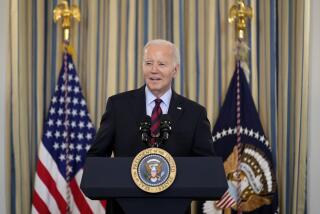Some Analysts See Stagflation Again Rearing Its Ugly Head
If the 1970s are considered something of a cultural wasteland, the economic record is even uglier.
The decade of Nixon, Ford and Carter spawned one of the most reviled economic terms: stagflation. Twice in the span of 10 years, the United States experienced a loathsome combination of high inflation in a stagnant, or declining, economy.
The year-over-year inflation rate peaked at 12.2% in 1974, fell back for two years, then resurged to 13.3% by 1979. The first peak came during one of the nationâs nastiest postwar recessions, and the second came during a time of barely sputtering growth.
These twin bouts of stagflation are popularly associated with the big oil price increases that hit the United States in 1973 and 1979.
However, a pair of economists from the University of Michigan, Robert Barsky and Lutz Kilian, contend that the main reason wasnât the oil shocks but monetary shocks caused by misguided âgo-and-stopâ credit policies of the Federal Reserve.
Barsky and Kilian say excess monetary growth drove economic output higher, as the Fed intended, in the early 1970s. When the Fed then hit the brakes with higher interest rates, the surge in business output died down. But demand didnât decline as sharply, in part because earlier monetary growth had helped raise inflation expectations in the economy--the idea of âbuy it now, it will only get more expensive.â
Another Fed-fueled monetary expansion in the late 1970s worsened that effect, and inflation zoomed again.
The theory is of more than academic interest because some Fed critics think the same thing is happening now.
âWeâre headed toward the worst of both worlds,â Toronto money manager Albert D. Friedberg said. âInflation is creeping upward, while the economy continues to stagnate.â
Friedberg pointed to Fridayâs government report showing that the economy grew at an annualized real rate of 2% in the first quarter, which was above expectations but still anemic compared with growth in recent years.
He thought a more significant, and worrisome, item in the report was the news that a key gauge of inflation rose at a 3.3% annual rate, the fastest increase in a year.
Instead of puzzling over the mysteries of productivity and worrying about whether the falling stock market would dampen consumer spending, Friedberg and other critics say, the Fed should be paying attention to its primary job: restraining inflation.
âThey should begin to talk about discipline and maybe think about raising rates rather than cutting them,â Friedberg said.
An inflation rate of 3% may seem benign, he said, but once an upward trend gets established, it is very difficult to reverse.
The second bout of 1970s inflation was halted only by a draconian series of interest rate increases engineered by then-Fed Chairman Paul Volcker. Volckerâs sustained tightening did finally squelch inflation, but at the cost of a severe recession in 1981-82.
More to Read
Inside the business of entertainment
The Wide Shot brings you news, analysis and insights on everything from streaming wars to production â and what it all means for the future.
You may occasionally receive promotional content from the Los Angeles Times.










